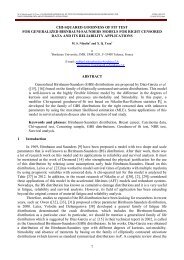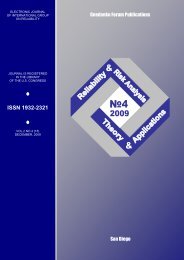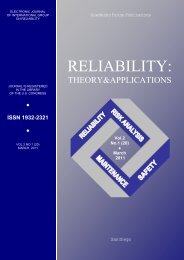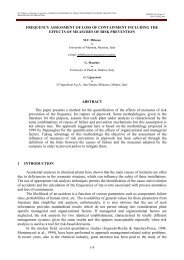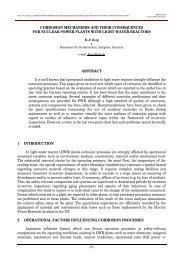Full Text in PDF - Gnedenko e-Forum
Full Text in PDF - Gnedenko e-Forum
Full Text in PDF - Gnedenko e-Forum
You also want an ePaper? Increase the reach of your titles
YUMPU automatically turns print PDFs into web optimized ePapers that Google loves.
R. Bri Stochastic age<strong>in</strong>g models – extensions of the classic renewal theory - RTA # 3-4, 2007, December - Special Issue[4] Bartlett, M.S. (1970). Renewal Theory. Meten &Co. Ltd. Science paperbacks, ISBN 412 20570 X.[5] Bri, R., Châtelet, E. & Yalaoui, F. (2003). Newmethod to m<strong>in</strong>imize the preventive ma<strong>in</strong>tenancecost of series–parallel systems. In ReliabilityEng<strong>in</strong>eer<strong>in</strong>g & System Safety, ELSEVIER, Vol.82, Issue 3, p.247-255.[6] Bri, R. & ep<strong>in</strong>, M. (2006). Stochastic age<strong>in</strong>gmodels under two types of failures. Proc. of the31st ESReDA SEMINAR on Age<strong>in</strong>g, SmoleniceCastle, Slovakia.[7] Gertsbakh, I.B. Asymptotic methods <strong>in</strong> reliability:A review. Adv. Appl. Prob. 16, 147-175.[8] Pyke, R. Markov renewal processes: Def<strong>in</strong>itionsand prelim<strong>in</strong>ary properties. Ann Math Statist 32,1231-1242.AppendixRenewal ProcessRenewal process serves for example to modelmathematically a device behaviour which isma<strong>in</strong>ta<strong>in</strong>ed <strong>in</strong> such a way that it stays runn<strong>in</strong>g as mosteffectively and longest as possible. May a file ofcomponents or the whole device with a time to afailure X (non-negative absolutely cont<strong>in</strong>uous randomvariable) with a dispersion given by a probabilitydensity f(t) exists and may a symbol t denotes forclearness a time. The first component is put <strong>in</strong>tooperation at time t = 0. Further, X 1 is a period whenthe first component comes to the failure and at thesame time it is substituted by a new identicalcomponent from a given file. It means that a renewalperiod (<strong>in</strong> this case a change period) is negligible, orequal to zero. This second component breaks downafter the period X 2 s<strong>in</strong>ce it started to operate. At thetime X 1 + X 2 the second component is renewed by theexchange for the third one and the process cont<strong>in</strong>uesfurther <strong>in</strong> such a way. The r-th renewal will happen atthe time S r = X 1 + X 2 +…+X r .If X 1, X 2… are <strong>in</strong>dependent non-negative equallydistributed random variables with a f<strong>in</strong>ite expectedvalue and dispersion,Sn0= 0, Sn= ∑ Xi, n∈N,i=1then a random process { } ∞ n n=0S is called a renewalprocess <strong>in</strong> a renewal theory. Sometimes an order ofstated random variables {X n } n=0 is denoted <strong>in</strong> thisway. In the case when a time distribution until thefailure is exponential, we speak about Poissonprocess. A function F n (t) <strong>in</strong>dicates a distributionfunction of a random variable S n. . There are a fewother random variables connected with the renewalprocess, which describe its behaviour (at time). Let wecall N t a number of renewals <strong>in</strong> the <strong>in</strong>terval [0, t] for afirm t 0, it meansNt= max{ n : S p t}nFrom this we also get that S Nt t < S Nt+1. Regard<strong>in</strong>gthe fact that the <strong>in</strong>terval [0, t] conta<strong>in</strong>s n failures (aswell as renewals) only if n th failure happens at thelatest at the time tP{ N ≥ n} = P{ S p t} F (t)t n=and the probability that at the time t there are nrenewals <strong>in</strong> the given renewal process can bedescribed <strong>in</strong> the follow<strong>in</strong>g wayP{ N n} = P{ S p t ∧ S ≥ t}t=n n+1= Fn[ − F ( t)] = F ( t)F ( )n( t) 1n+ 1 n−n+1tProvided that X 1, X 2… are <strong>in</strong>dependent non-negativeequally distributed random variables and P r (X 1 = 0)




